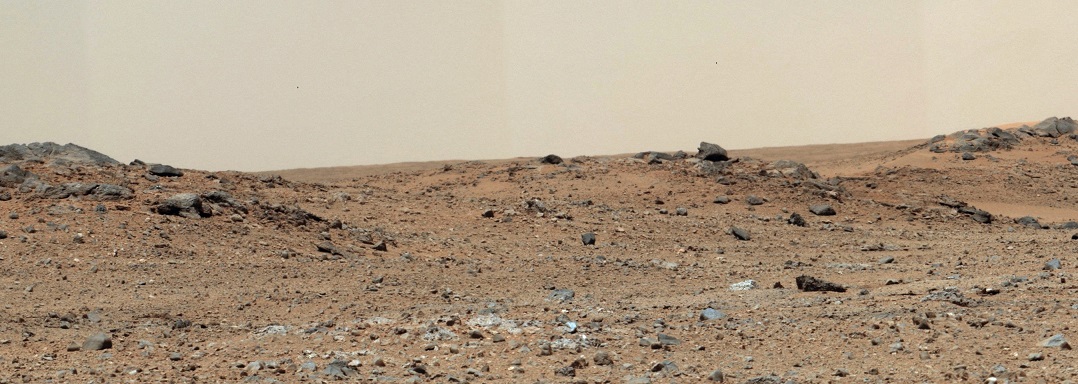Martian ShergottiteIgneous stony meteorite with a Martian origin consisting mainly of plagioclase (or a shocked glass of plagioclase composition) and pyroxene. They are the most abundant type of SNC meteorites and the type member is the Shergotty meteorite, which fell in India in 1865. Shergottites are igneous rocks of volcanic or Click on Term to Read More
augite-rich ∗
(depleted, maficOne of the two broad categories of silicate minerals, the other being felsic, based on its magnesium (Mg) and/or iron (Fe) content. Mafic indicates silicate minerals that are predominantly comprised of Mg and/or Fe.The term is derived from those major constituents: Magnesium + Ferrum (Latin for iron) + ic (having Click on Term to Read More)
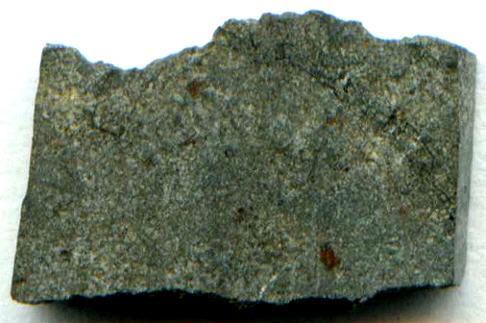
Found 2013
no coordinates recorded At the 2013 Denver Gem and MineralInorganic substance that is (1) naturally occurring (but does not have a biologic or man-made origin) and formed by physical (not biological) forces with a (2) defined chemical composition of limited variation, has a (3) distinctive set of of physical properties including being a solid, and has a (4) homogeneous Click on Term to Read More Show, meteoriteWork in progress. A solid natural object reaching a planet’s surface from interplanetary space. Solid portion of a meteoroid that survives its fall to Earth, or some other body. Meteorites are classified as stony meteorites, iron meteorites, and stony-iron meteorites. These groups are further divided according to their mineralogy and Click on Term to Read More dealer Blaine Reed was asked by a fellow meteorite dealer (S. Tutorow) to sort through a box of at least a hundred ‘likely terrestrial’ rocks remaining in a bulk shipment sent from a Moroccan dealer (B. Tahiri). During his examination he noticed a small 149.4 g stone with visible shock veins and thought it was probably a eucriteMost common type of achondrite meteorite and a member of the HED group. Eucrites are basalts composed primarily of pigeonite and anorthite (An60-98). Eucrites have been placed into three subgroups based on mineralogical and chemical differences. • Non-cumulate eucrites represent the upper crust that solidified on a magma ocean after Click on Term to Read More; however, an XRF probe on a cut face indicated that the meteorite was possibly martian. The owner subsequently brought this stone to the University of New Mexico (C. Agee) for analysis and classification, and NWA 8159 was determined to be a new martian type—augite-rich basaltBasalt is the most common extrusive igneous rock on the terrestrial planets. For example, more than 90% of all volcanic rock on Earth is basalt. The term basalt is applied to most low viscosity dark silicate lavas, regardless of composition. Basalt is a mafic, extrusive and fine grained igneous rock Click on Term to Read More. For his part in recovering this rare meteorite, Mr. Reed was kindly given a 2.2 g section.
Based on the initial submitted samples as well as subsequent analyses (Herd
et al., 2017), the modal composition of NWA 8159 was determined to be
augiteHigh-Ca clinopyroxene, (Ca,Mg,Fe)SiO3, that occurs in many igneous rocks, particularly those of basaltic composition. In order to be considered augite, the clinopyroxene must contain 20 to 45 mol % of calcium (Wo20 - 45). An important and unique Martian meteorite is NWA 8159, that has been classified as an augite basalt. Click on Term to Read More (~48–50%),
plagioclaseAlso referred to as the plagioclase feldspar series. Plagioclase is a common rock-forming series of feldspar minerals containing a continuous solid solution of calcium and sodium: (Na1-x,Cax)(Alx+1,Si1-x)Si2O8 where x = 0 to 1. The Ca-rich end-member is called anorthite (pure anorthite has formula: CaAl2Si2O8) and the Na-rich end-member is albite Click on Term to Read More (both crystalline and
amorphousMaterial without the regular, ordered structure of crystalline solids. Amorphous substances, like glass, lack a definite repeating pattern in their atomic structures (crystallinity). There may be small regions of order, but, overall there is disorder. Click on Term to Read More present in approximately equal proportions: ~37–40%),
olivineGroup of silicate minerals, (Mg,Fe)2SiO4, with the compositional endpoints of forsterite (Mg2SiO4) and fayalite (Fe2SiO4). Olivine is commonly found in all chondrites within both the matrix and chondrules, achondrites including most primitive achondrites and some evolved achondrites, in pallasites as large yellow-green crystals (brown when terrestrialized), in the silicate portion Click on Term to Read More (~5%),
magnetiteFe oxide, Fe2+Fe3+2O4, containing oxidized iron (Fe3+) found in the matrix of carbonaceous chondrites and as diagnostic component in CK chondrites. In CK chondrites, magnetite is typically chromian, containing several wt. % Cr2O3. Click on Term to Read More (~5%), maghemite (~0.5%), and
orthopyroxeneOrthorhombic, low-Ca pyroxene common in chondrites. Its compositional range runs from all Mg-rich enstatite, MgSiO3 to Fe-rich ferrosilite, FeSiO3. These end-members form an almost complete solid solution where Mg2+ substitutes for Fe2+ up to about 90 mol. % and Ca substitutes no more than ~5 mol. % (higher Ca2+ contents occur Click on Term to Read More (~1–2%), along with minor amounts of
ilmeniteTi-Fe oxide, TiFeO3, found in achondrites, lunar mare basalts, and shergottites. Ilmenite forms as a primary mineral in mafic igneous rocks. It crystallizes relatively early out of a magma before most of the other minerals, and as a result, the heavier crystals of ilmenite precipitate to the bottom of the magma Click on Term to Read More, merrillite, Cl-apatite, and Cr-spinel. Sharp
et al. (2015) reported the presence of shock-melt veins of unique texture associated with
high-pressure mineral phasesMineral forms that are stable only at the extremely high pressures typical of Earth's deep interior, but not its surface. Such pressures also are generated instantaneously during meteorite impact. For example, coesite and stishovite are high-pressure polymorphs of SiO2 (silica) and diamond is a high-pressure modification of graphite (carbon). The Click on Term to Read More including majoritic
garnetMineral generally found in terrestrial metamorphic rocks, although igneous examples are not uncommon. Garnet is a significant reservoir of Al in the Earth's upper mantle. The garnet structure consists of isolated SiO4 tetrahedra bound to two cation sites. The A site holds relatively large divalent cations (Ca2+, Mg2+, Fe2+, Mn2+); the Click on Term to Read More,
stishoviteDense, high-pressure phase of quartz; so far identified only in shock-metamorphosed, quartz-bearing rocks from meteorite impact craters. Stishovite was synthesized in 1961 before it was discovered at Meteor Crater, Arizona. Its structure consists of parallel chains of single SiO6 octahedra. The octahedra are on their sides, sharing opposing edges. Image Click on Term to Read More,
coesiteHigh-pressure polymorph of silicon dioxide (SiO2). Has the same chemical composition as cristobalite, stishovite, seifertite and tridymite but possesses a different crystal structure. Coesite forms at intense pressures of above about 2.5 GPa (25 kbar) and temperature above about 700 °C, and was first found naturally on Earth in impact Click on Term to Read More, tissintite (a Ca-analog of jadeite), and ahrensite (an Fe-analog of
ringwooditeHigh-pressure olivine polymorph with a spinel structure that is found in highly shocked meteorites (above ~50 GPa, shock level > S5) and the Earth's transition zone mantle (~13 GPa). Under even higher pressure in the lower mantle (~24 GPa), ringwoodite decomposes into perovskite (Mg,Fe)SiO3, and magnesiowüstite (Mg,Fe)O, whose properties are Click on Term to Read More), the two latter phases having been discovered in the Tissint shergottite (Ma
et al., 2014). These high-pressure mineral phases are indicative of a weak to moderate
shock stageA petrographic assessment, using features observed in minerals grains, of the degree to which a meteorite has undergone shock metamorphism. The highest stage observed in 25% of the indicator grains is used to determine the stage. Also called "shock level". Click on Term to Read More (~15–23 GPa; Herd
et al., 2017) and a high temperature (~2000°C).
In their analysis of a shock melt vein in NWA 8159, Hu and Sharp (2016) observed high-pressure phases along with
maskelyniteNatural glass composed of isotropic plagioclase produced during shock metamorphism (not melting) at pressures of ~30 GPa. Maskelynite is commonly found in shergottites though also found in some ordinary chondrites, HED and lunar meteorites. It is also found in association with meteorite impact craters and crater ejecta. Named after British Click on Term to Read More and partially amorphized plagioclase associated with shear along a shock melt vein. These phases were probably produced by solid-state transformation during a localized shock event without significant melting. In a nano-scale mineralogical study of shock veins in NWA 8159, Sharp and Walton (2016) determined that the high-pressure minerals were formed under weak shock pressures of ~16 GPa and were rapidly quenched to temperatures below 1200 K within seconds preventing the formation of post-shock back-transformation phases; such rapid quenching also prevented isotopic resetting. Other features of NWA 8159 are also indicative of rapid cooling, including its fine-grained texture, the intergrown assemblages of augite, plagioclase, and magnetite crystals, and the presence of metastable
pyroxeneA class of silicate (SiO3) minerals that form a solid solution between iron and magnesium and can contain up to 50% calcium. Pyroxenes are important rock forming minerals and critical to understanding igneous processes. For more detailed information, please read the Pyroxene Group article found in the Meteoritics & Classification category. Click on Term to Read More phases.
In their investigation of the shock history of NWA 8159, Sharp
et al. (2019) determined that the meteorite experienced a comparatively long shock pulse duration of 100 ms. They described an impact scenario, consistent with all of the measured shock parameters of NWA 8159, in which the ejected
meteoroidSmall rocky or metallic object in orbit around the Sun (or another star). originated some distance from the point of impact of an object ~1 km in diameter. Other known
shergottitesIgneous stony meteorite with a Martian origin consisting mainly of plagioclase (or a shocked glass of plagioclase composition) and pyroxene. They are the most abundant type of SNC meteorites and the type member is the Shergotty meteorite, which fell in India in 1865. Shergottites are igneous rocks of volcanic or Click on Term to Read More that may have been ejected during the same event were located closer to the point of impact and experienced higher shock pressures (>20 GPa) and shorter shock pulse durations (~10–20 ms).
It was initially considered by some that NWA 8159 could possibly represent an extruded evolved intercumulus melt that was displaced from below, and which contained a low abundance of xenocrystic olivines spalled from the walls of the
nakhliteOne of the Martian SNC meteorites, nakhlites are basaltic cumulate clinopyroxenite rocks, and most all are comprised mainly of sub-calcic augite with approximately 10% Fe-rich olivine (giving the augite a green color) that are set in a very fine-grained matrix (mesostasis) comprised of plagioclase, K-feldspar, clinopyroxene, Fe-Ti oxide (Ti-magnetite), sulfide, Click on Term to Read More magmaMolten silicate (rock) beneath the surface of a planetary body or moon. When it reaches the surface, magma is called lava. Click on Term to Read More chamber (Herd
et al., 2014). Notably, NWA 8159 has a similar δ
37Cl value as the nakhlites, 1.5‰
vs. 1.8‰, respectively (Sharp
et al., 2016). However, the Sm–Nd-based
crystallizationPhysical or chemical process or action that results in the formation of regularly-shaped, -sized, and -patterned solid forms known as crystals. Click on Term to Read More age for NWA 8159 was determined to be 2.37 (±0.25) b.y. (Herd
et al., 2017), which is significantly older than the ~1.3 b.y. Sm–Nd age of the nakhlites (Simon
et al., 2014). Based on Ar–Ar chronometry, a minimum age of 2.15 (±0.10) b.y. was obtained for a shock melt vein in NWA 8159; however, the timing of melt vein formation has not yet been established (Cassata, 2016). Based on the results of cosmogenic
nuclideA nuclear species characterized by Z protons and N neutrons. Click on Term to Read More studies, Herd
et al. (2017) calculated the pre-atmospheric size of NWA 8159 to be 0.6–1.2 m in diameter.
Coincidentally, the crystallization age of NWA 8159 is consistent with the 2.403 (±0.140) b.y. Sm–Nd age determined for the depleted, mafic, olivine–plagioclase-phyric shergottite NWA 7635 (Righter
et al., 2014). Both NWA 8159 and NWA 7635 also share similar
REEOften abbreviated as “REE”, these 16 elements include (preceded by their atomic numbers): 21 scandium (Sc), 39 Yttrium (Y) and the 14 elements that comprise the lanthanides excluding 61 Promethium, an extremely rare and radioactive element. These elements show closely related geochemical behaviors associated with their filled 4f atomic orbital. Click on Term to Read More abundances (unique HREE) and pyroxene compositions; in fact, Herd
et al. (2017) suggest that a classification for NWA 7635 as an augite-rich shergottite would also be appropriate. Moreover, they determined that NWA 8159 and NWA 7635 have very similar ejection ages (~1.2 m.y. and ~1.0 m.y., respectively), and speculate that both meteorites may be launch paired. Notably, at least 16 additional depleted shergottites have a similar ejection age (Irving
et al., 2017;
#2068), and despite some having much younger crystallization ages (as young as 348 m.y.), all of these depleted shergottites might be associated with a common ~2 b.y.-old
volcanicIgneous rock that forms from cooling magma on the surface of a planet or asteroid. site (Lapen
et al., 2017;
diagram).
The terrestrial ages calculated for NWA 8159 and NWA 7635 are 230 (±60) t.y. and 2.3 (±1.3) t.y., respectively, but this does not exclude a common Mars ejection event. Nevertheless, Kruijer
et al. (2017;
diagram) determined that these two meteorites have disparate ε
182W values of 1.13 (±0.10) and 1.80 (±0.13), respectively. This corresponds to a later formation of the source for NWA 8159 by more than 5 m.y., possibly reflecting a re-melting event in the
mantleMain silicate-rich zone within a planet between the crust and metallic core. The mantle accounts for 82% of Earth's volume and is composed of silicate minerals rich in Mg. The temperature of the mantle can be as high as 3,700 °C. Heat generated in the core causes convection currents in Click on Term to Read More, and therefore a common source-crater pairing is doubtful.
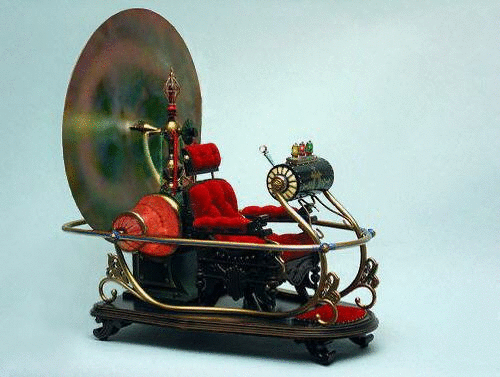
mouseover the time machine set to 230 t.y. before present
For additional information on the crystallization and ejection age of NWA 7635 and similar shergottites, read the
PSRD article by G. Jeffrey Taylor: ‘
Two Billion Years of Magmatism in One Place on Mars‘, May 2017.
Further evidence supporting a unique martian source region for NWA 8159 was presented by Kayzar
et al. (2015) through a coupled Nd–W diagram, and by Herd
et al. (2015) through a coupled O–Cr diagram; these clearly demonstrate that NWA 8159 is resolved from other martian mantle reservoirs (see below).
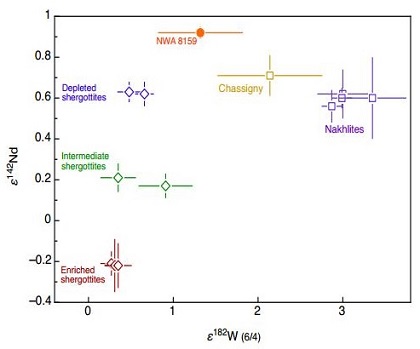
Diagram credit: Kayzar
et al., 46th LPSC,
#2357 (2015)
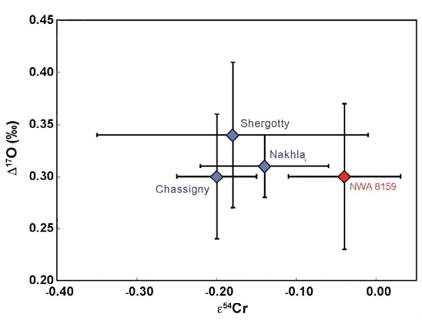
Diagram credit: Herd
et al.,
GCA, vol. 218, p. 20 (2017)
‘The Northwest Africa 8159 martian meteoriteOver 30 of the meteorites found on Earth almost certainly came from Mars (see http://www.imca.cc/mars/martian-meteorites.htm and http://www2.jpl.nasa.gov/snc/). All but one belongs to the group known as SNC meteorites, which includes the shergottites, nakhlites, and chassignites. SNC meteorites contain minerals that crystallized within the past 1.35 to 0.15 Ga, making them Click on Term to Read More: Expanding the martian sample suite to the early Amazonian’
(https://dx.doi.org/10.1016/j.gca.2017.08.037) An O-isotopic analysis was conducted at the University of New Mexico (K. Ziegler), and the values
plot on the martian
fractionationConcentration or separation of one mineral, element, or isotope from an initially homogeneous system. Fractionation can occur as a mass-dependent or mass-independent process. Click on Term to Read More line. The CRE age for NWA 8159 was calculated for both shock melt glass and bulk rock, which yielded an age of ~1.5 and ~1.1 b.y., respectively (Cassata, 2016). In addition, they identified a martian atmospheric Xe component, but the timing of its incorporation is so far indeterminate.
Utilizing Nd–Nd isochron age models, an age of 4.504 (±0.005) b.y. has been calculated for the parental source region of the martian shergottites. On the same basis, a younger age of 4.451(+0.020/–0.013) b.y. was calculated by Kayzar
et al. (2015) for the parental source region of NWA 8159. However, to account for the much higher ε
182W value obtained for NWA 8159 (~ +1.3) compared to that of typical shergottites (~ +0.2 to +0.9) , the initial content of the
182Hf parent
isotopeOne of two or more atoms with the same atomic number (Z), but different mass (A). For example, hydrogen has three isotopes: 1H, 2H (deuterium), and 3H (tritium). Different isotopes of a given element have different numbers of neutrons in the nucleus. Click on Term to Read More would necessarily have been significantly higher given its relatively short
half-lifePeriod of time required for 50% (½) of the atoms of a radioactive nuclide in a sample to decay. After two half-lives, 25% ( ½ x ½ = 1/4) of the original radioactive nuclide will remain. After three half-lives, 12.5% ( ½ x ½ x ½ = 1/8) of the original radioactive nuclide will remain. Click on Term to Read More of 8.9 m.y. (
i.e.,
182Hf would have been virtually extinct by the time the source for NWA 8159 was formed). Therefore, it was concluded that NWA 8159 experienced a more complex fractionation history than typical basaltic shergottites, possibly forming at much greater depths within the martian mantle, and the Nd–Nd age calculated for its source region might not be accurate.
Studies by Agee
et al. (2014) show that NWA 8159 contains an unusually pure form of magnetite compared to that of other martian meteorites, and they recognized that this magnetite represents the most
oxidizedOxidation and reduction together are called redox (reduction and oxidation) and generally characterized by the transfer of electrons between chemical species, like molecules, atoms or ions, where one species undergoes oxidation, a loss of electrons, while another species undergoes reduction, a gain of electrons. This transfer of electrons between reactants Click on Term to Read More martian material analyzed thus far. In addition, they discovered that the typical correlation between LREE pattern and
oxidationOxidation and reduction together are called redox (reduction and oxidation) and generally characterized by the transfer of electrons between chemical species, like molecules, atoms or ions, where one species undergoes oxidation, a loss of electrons, while another species undergoes reduction, a gain of electrons. This transfer of electrons between reactants Click on Term to Read More state that is present in other martian meteorites is not observed in this meteorite, providing further evidence for a unique petrogenetic history. The parental source composition for NWA 8159 was LREE depleted in a similar manner to the depleted, high-Al basaltic martian meteorite QUE 94201, which is considered to be a product of extensive
silicateThe most abundant group of minerals in Earth's crust, the structure of silicates are dominated by the silica tetrahedron, SiO44-, with metal ions occurring between tetrahedra). The mesodesmic bonds of the silicon tetrahedron allow extensive polymerization and silicates are classified according to the amount of linking that occurs between the fractionation of a Y-980459-like primary mantle melt (Kayzar
et al., 2015; Treiman and Filiberto, 2014). However, although NWA 8159 crystallized from an evolved melt, it is the conclusion of Herd
et al. (2017), based in part on the bulk rock Sm–Nd and W–Nd values, that NWA 8159 represents a near primary mantle melt derived from a unique, more highly incompatible element-depleted martian mantle reservoir.
Based on petrographic, mineralogical, chemical, and isotopic similarities, it has been suggested that the olivine-phyric basaltic shergottite NWA 10416 might be genetically related to NWA 8159. Of particular note, both meteorites contain shock features and veins associated with a similar suite of high-pressure minerals and feldspathic glass phases. At the same time, a significant abundance of primary crystalline
feldsparAn alumino-silicate mineral containing a solid solution of calcium, sodium and potassium. Over half the Earth’s crust is composed of feldspars and due to their abundance, feldspars are used in the classification of igneous rocks. A more complete explanation can be found on the feldspar group page. Click on Term to Read More still remains in NWA 8159 with much less persisting in NWA 10416, while in other martian basalts complete transformation to maskelynite has occurred (Walton
et al., 2016). In addition, Vaci
et al. (2016) employed multiple high-precision techniques and recognized that both meteorites likely experienced a low degree of
parent bodyThe body from which a meteorite or meteoroid was derived prior to its ejection. Some parent bodies were destroyed early in the formation of our Solar System, while others like the asteroid 4-Vesta and Mars are still observable today. Click on Term to Read More aqueous alteration, which is evident in the replacement of olivine cores by micro-scale hydrated minerals including a Mg-bearing form of a ferric iron-bearing
fayalitePure* iron end-member (Fe2SiO4) of the olivine solid solution series and an important mineral in meteorites. When iron (Fe) is completely substituted by magnesium, it yields the the pure Mg-olivine end-member, forsterite (Mg2SiO4). The various Fe and Mg substitutions between these two end-members are described based on their forsteritic (Fo) Click on Term to Read More known as laihunite.
Following the classification of NWA 8159, the 2.2 g block held by Mr. Reed was cut into two thin slices, from which smaller specimens were broken for distribution. The specimen of NWA 8159 shown above is a 0.25 g interior partial slice. The photo below shows the
main massLargest fragment of a meteorite, typically at the time of recovery. Meteorites are commonly cut, sliced or sometimes broken thus reducing the size of the main mass and the resulting largest specimen is called the "largest known mass". Click on Term to Read More sectioned in half.
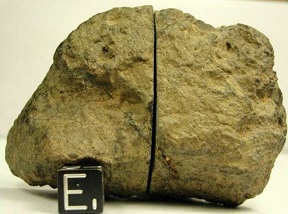
Photo credit: Herd
et al.,
GCA, vol. 218, p. 5 (2017)
‘The Northwest Africa 8159 martian meteorite: Expanding the martian sample suite to the early Amazonian’
(http://dx.doi.org/10.1016/j.gca.2017.08.037)
∗ Recent geochemical research on the martian basalts has led to new petrogenetic models and classification schemes.read more >>
